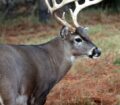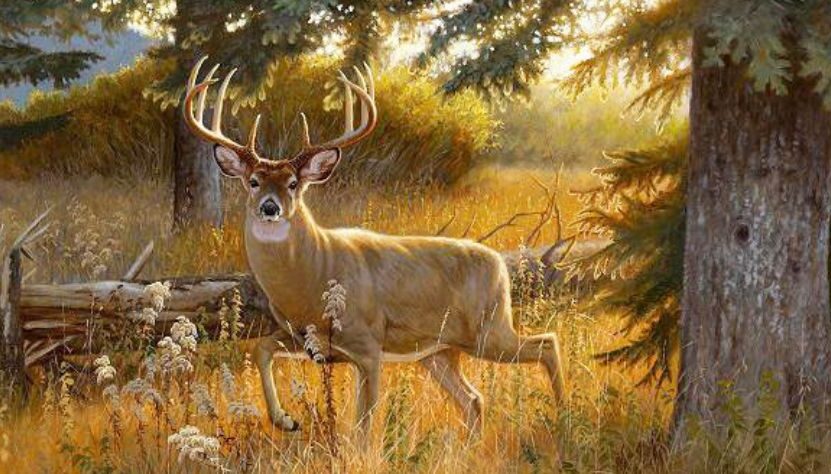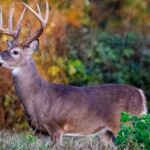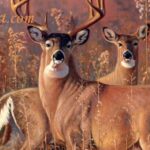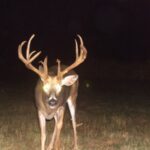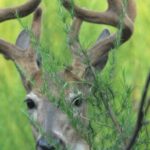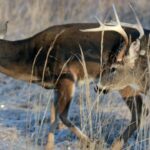Editor’s Note: Two ways of bagging a buck include luck, which is a factor that a majority of hunters in many areas depend on solely, and experience—knowing the buck, his movement patterns, his behavior patterns, and what causes him to move from one place to another. Being able to predict deer movement is an important trait of the hunter who bags a buck year after year. Only a small amount of guesswork is involved in this type of hunting. The sportsman takes a set of given facts, studies the terrain, the available food, the deer’s mating habits, and the weather in his region, correlates them with deer signs he finds where he’s hunting, and comes up with a hunt plan that logically will put him in a position to see and have the best odds to bag a buck on any given day he hunts.

After the deer have felt hunting pressure, their movement patterns change, especially when there’s considerable pressure on the animals from other hunters. Due to these hunter encounters during daylight hours, deer will begin to feed after dark and stay away from food sources until night. Therefore, tree stands and ground blinds will have to be moved from the food source to another place if you want to consistently bag deer. However, to know where to move your tree stand, additional scouting is required.
“One of the signs that indicate a hunter should begin to scout for a new place to put his tree stand is when he sees deer entering the field from several different directions, instead of coming out next to his stand,” Dr. Robert Sheppard of Tuscaloosa, Alabama, a longtime deer-hunting instructor, comments. “He or she may find that when he moves his stand to set up an ambush, the deer still won’t consistently come out in the same place every day. He also may notice that he doesn’t see as many deer come into the field during daylight hours, but after a rain, he observes just as many tracks in the field as he has at the beginning of the season. To put your stand in a more productive area, the most effective technique is to back that stand up to a point in the woods that the deer are coming to before entering the field after dark.
“To locate this area, I scout on the days when the weather conditions or wind conditions aren’t right for hunting. Common sense is your best tool for finding that staging area after the deer have quit showing up in the field. The most reliable signs for locating deer are finding places in the woods where the deer’s feet have hit the ground regularly. You can learn this information by scouting intensively and using your trail cameras. You can go to the trail that you’ve been hunting effectively earlier in the season and follow the trail away from the field into the woods. I’ve gotten down on my hands and knees before to track deer further back into the woods away from a primary food source, 2 to 3 weeks after bow season has begun. By using this tracking method, you may not understand the total deer movement patterns. However, you’ll have a better picture of what the deer are doing, and where you should place your tree stand than you’ll have by sitting on the edge of the field, waiting for the deer to show up.
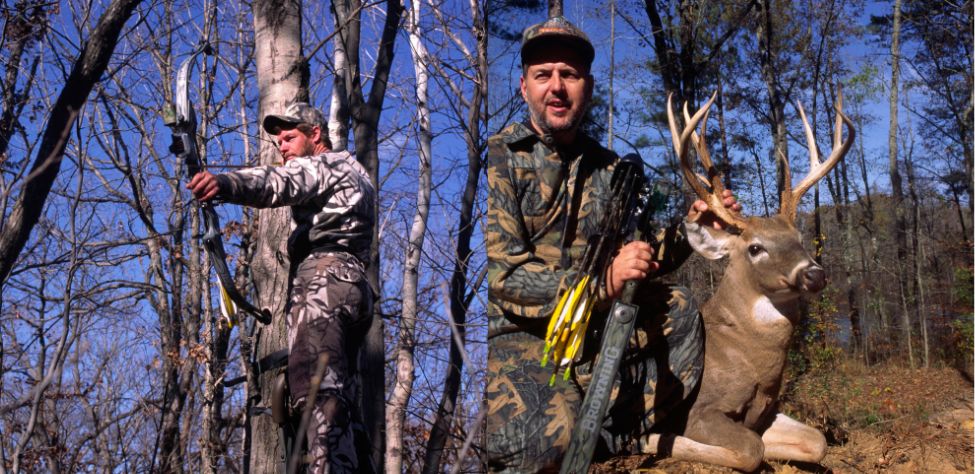
“You may backtrack one deer 100 yards and discover a site where two or three trails cross. Or, you may continue to follow a trail and locate the edge of a slough, where there may be 40 deer walking down that slough edge regularly. So, by following one deer trail away from the food source, more than likely you’ll locate a place where many of the deer that are using that field as a food source will concentrate before entering their feeding ground. Once you discover a place like this, you’ll see many tracks going in both directions. Set up your stand here for the next week or two.
“But instead of relying totally on one of these staging regions away from the field, the consistent hunter will follow four or five trails out of the field going in different directions to other staging areas. In each of these staging areas, he’ll locate a tree for his tree stand. If he’s a bowhunter, he’ll cut shooting lanes in four directions from the tree where he plans to place his stand. With his compass and GPS, he’ll determine what direction his tree stand will be facing to learn which way the wind must be blowing from to be able to hunt out of that stand. By that, I mean, if his tree stand faces to the north, then the best time for him to hunt out of that stand so that his scent won’t be carried into his hunting area will be when there’s a prevailing north, northwest, or northeast wind.
“Using this system of patterning deer, the hunter needs at least one tree stand he can hunt in the deer’s staging area, no matter what the wind condition is. After he has taken his deer from one of these regions or has shot at and missed a deer in these staging areas, the deer begin to learn that they’re in danger when they enter this staging zone. They’ll start showing up in fewer numbers and, finally, not at all during the daylight hours. The deer will wait later in the evening to enter the field or come out earlier in the morning. Deer hunting becomes harder. You’ll begin to backtrack the deer even further from the staging area, and the trailing gets harder because there are more leaves on the ground, and following the deer’s tail becomes more difficult.”
Looking for more content? Check out our YouTube channel and watch “How to Get the Shot” by John E. Phillips.
Expert Guidebooks on BowHunting Deer: Best Sellers

How to Hunt Deer Up Close with Bows, Rifles, Muzzleloaders and Crossbows
To be more successful as a deer hunter, learn all you can about the animal, the wind, the temperature and the techniques required to get in close.
In this book, you’ll hear about some of the best hunters in the nation who know how to hunt deer close, including one of the greatest archers who ever lived, Howard Hill.
John E. Phillips also shares his own deer stories and hunting tips from 50 years of experience.
VERSIONS: AUDIBLE, KINDLE & PRINT
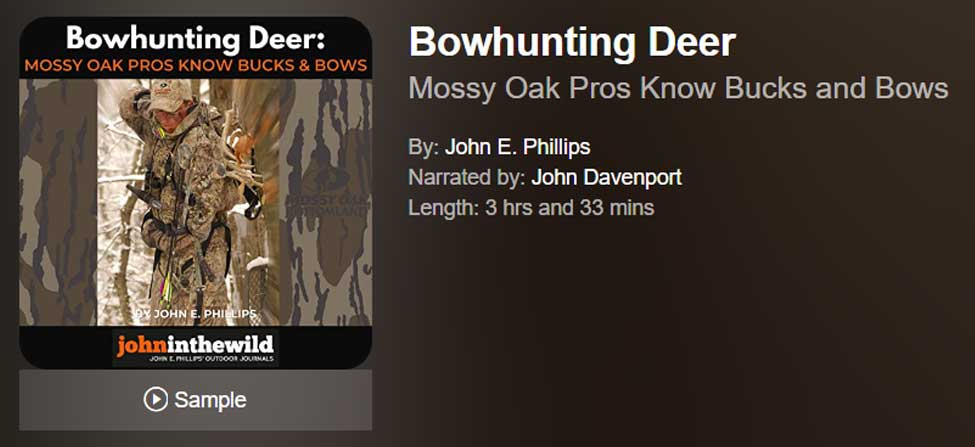
Many deer hunters have told me: “I want a deer-hunting book with regular hunters who are just like me” and “I want a deer-hunting book with the best advice from the best professional deer hunters in the nation”.
Mossy Oak’s Pro Staff is made up of some of the nation’s best deer hunters, professional deer hunters, and TV hosts whose names and advice often are heard in deer camps all over the nation. But many of the more than 1,000 Mossy Oak Pro Staff hunters are everyday, weekend, and vacation deer hunters just like you.
Whether you hunt private or public lands, you’ll find tips and tactics in this book from the Mossy Oak Pro Staff that will increase your odds for locating and taking the bucks of your dreams.
If you’re serious about learning to hunt and take deer with a bow, if you’re looking for a different strategy that will help you identify and harvest big bucks, if you want to learn from your misses as well as from the shots that connect, and if you enjoy being in the great outdoors that the Good Lord has blessed us with, then this book is for you.
VERSIONS: AUDIBLE, KINDLE & PRINT

How to Hunt and Take Big Buck Deer on Small Properties
In this book, you’ll hear from 14 hunters who either have gained permission or leased properties as small as six acres to as much as 250 acres, and how they consistently take older-age-class bucks off these little lands.
VERSIONS: AUDIBLE, KINDLE & PRINT

Jim Crumley’s Secrets of Bowhunting Deer
Using a black magic marker and a gray work jumpsuit, Jim Crumley of Buchanan, Virginia, drastically changed the nature and purpose of hunting camouflage when he created the first sportsman’s camouflage – Trebark. Crumley’s love of bowhunting and his desire to be more invisible changed hunting clothing forever.
In this hunting guide, he shares the wisdom that he’s learned throughout his lifetime about how to be a hunter, how to find a deer lease, how to scout for deer, and more.
Special features include how to:
- Have a magic 60 acres to hunt
- Decide the best equipment to use
- Find deer year-round
- Locate land to hunt
- Know the best place to put your tree stand
- Get bucks within bow range
VERSIONS: AUDIBLE, KINDLE & PRINT

How to Hunt Deer Like a Pro
How do you know if the land you hunt has a trophy deer on it? Wildlife manager Bob Zaiglin, of Uvalde, Texas and Jim Crumley, the father of modern-day hunting camouflage, tells you how to find out. GPS can make finding and taking that trophy buck easier. This hunting guide will teach you how to hunt big bucks where no one else can find them, how to call deer, and how to become versatile as a deer hunter, so that if one deer tactic doesn’t work, another one will.
In the chapter, “How to find Bucks at Scrape,” Dr. Keith Causey, retired professor of Wildlife Science at Auburn University, describes the best way to hunt a scrape.
Brad Harrison of Neosho, Missouri, is a nationally-known videographer, professional deer hunter and master at calling deer. Another master is Will Primos of Primos Game Calls. These two experts will tell the best deer calls and when to use them in this book.
And for over 20 years, Bo Pitman, lodge manager of White Oak Plantation, has been studying deer movement patterns. He explains what types of conditions are best for predicting deer movement.
VERSIONS: AUDIBLE, KINDLE & PRINT

Deer hunting and deer hunters are drastically changing each year. To learn new techniques for hunting deer and have more places to hunt, I’ve interviewed some of the best deer hunters in the nation and share their tactics in How to Hunt Deer Like a Pro: Volume II.
In Chapter 10, Jacob Lamar tells you his tactics for consistently taking older-age-class bucks on public lands in several states. Chapter 11, Bob Walker explains how to find places on public lands where you can hunt that 99 percent of the other hunters never have considered hunting. The Bonus Chapter with David Ramey tells you how, where, when and with what equipment to take big Kansas bucks on public lands by hunting in 100-degree weather when others won’t hunt.
Chapter 13, Mark Drury, his family and his guests take mature bucks every season by having more small places to hunt rather than one large property. Drury explains the strategy of having satellite farms to hunt that only may be 50-150 acres each or less. Chapter 15, Pat Reeve, who hunts far-northern states and Canada, says, “I don’t like hunting for mature bucks until the weather is 20 degrees or less.” Chapter 4, Dr. Larry Marchinton says that funnels are the most-reliable stand sites to hunt for big bucks and tells why.
VERSIONS: AUDIBLE & PRINT
Tomorrow: Scout and Hunt Deer at the Season’s End

